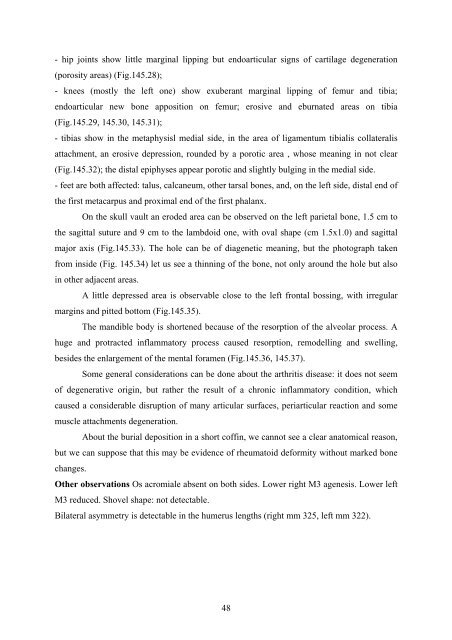Anthropological description of skeletons from graves no. 123, 124 ...
Anthropological description of skeletons from graves no. 123, 124 ...
Anthropological description of skeletons from graves no. 123, 124 ...
Create successful ePaper yourself
Turn your PDF publications into a flip-book with our unique Google optimized e-Paper software.
- hip joints show little marginal lipping but endoarticular signs <strong>of</strong> cartilage degeneration<br />
(porosity areas) (Fig.145.28);<br />
- knees (mostly the left one) show exuberant marginal lipping <strong>of</strong> femur and tibia;<br />
endoarticular new bone apposition on femur; erosive and eburnated areas on tibia<br />
(Fig.145.29, 145.30, 145.31);<br />
- tibias show in the metaphysisl medial side, in the area <strong>of</strong> ligamentum tibialis collateralis<br />
attachment, an erosive depression, rounded by a porotic area , whose meaning in <strong>no</strong>t clear<br />
(Fig.145.32); the distal epiphyses appear porotic and slightly bulging in the medial side.<br />
- feet are both affected: talus, calcaneum, other tarsal bones, and, on the left side, distal end <strong>of</strong><br />
the first metacarpus and proximal end <strong>of</strong> the first phalanx.<br />
On the skull vault an eroded area can be observed on the left parietal bone, 1.5 cm to<br />
the sagittal suture and 9 cm to the lambdoid one, with oval shape (cm 1.5x1.0) and sagittal<br />
major axis (Fig.145.33). The hole can be <strong>of</strong> diagenetic meaning, but the photograph taken<br />
<strong>from</strong> inside (Fig. 145.34) let us see a thinning <strong>of</strong> the bone, <strong>no</strong>t only around the hole but also<br />
in other adjacent areas.<br />
A little depressed area is observable close to the left frontal bossing, with irregular<br />
margins and pitted bottom (Fig.145.35).<br />
The mandible body is shortened because <strong>of</strong> the resorption <strong>of</strong> the alveolar process. A<br />
huge and protracted inflammatory process caused resorption, remodelling and swelling,<br />
besides the enlargement <strong>of</strong> the mental foramen (Fig.145.36, 145.37).<br />
Some general considerations can be done about the arthritis disease: it does <strong>no</strong>t seem<br />
<strong>of</strong> degenerative origin, but rather the result <strong>of</strong> a chronic inflammatory condition, which<br />
caused a considerable disruption <strong>of</strong> many articular surfaces, periarticular reaction and some<br />
muscle attachments degeneration.<br />
About the burial deposition in a short c<strong>of</strong>fin, we can<strong>no</strong>t see a clear anatomical reason,<br />
but we can suppose that this may be evidence <strong>of</strong> rheumatoid deformity without marked bone<br />
changes.<br />
Other observations Os acromiale absent on both sides. Lower right M3 agenesis. Lower left<br />
M3 reduced. Shovel shape: <strong>no</strong>t detectable.<br />
Bilateral asymmetry is detectable in the humerus lengths (right mm 325, left mm 322).<br />
48

















